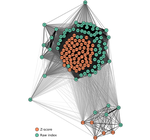Abstract
Pairwise ecological resemblance, which includes compositional similarity between sites (beta diversity), or associations between species (co-occurrence), can be measured by >70 indices. Classical examples for presence–absence data are Jaccard index or C-score. These can be expressed using contingency table matching components a, b, c, and d—the joint presences, presences at only one site/species, and joint absences.
Using simulations of point patterns for two species with known magnitude of association, I demonstrate that most of the indices converge to a similar value and they describe the simulated association almost identically, as long as they are calculated as a Z-score, that is, as deviation of the index from a null expectation. Further, I show that Z-scores estimate resemblance on average better than raw forms of the indices, particularly in the face of confounding effects of spatial scale and conspecific aggregation. Finally, I show that any single of the matching components, when expressed as Z-score, can be used as an index that performs as good as the classical indices; this also includes joint absences.
All this simplifies selection of the right resemblance index, it underscores the advantage of expressing resemblance as deviation from a null expectation, and it revives the potential of joint absences as a meaningful ecological quantity.
